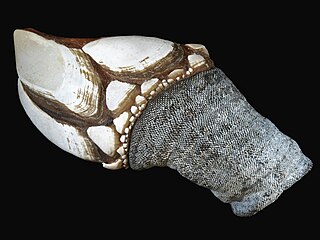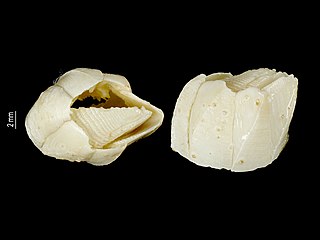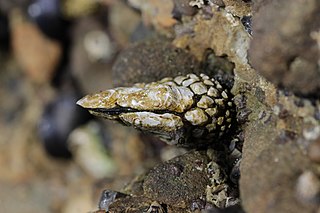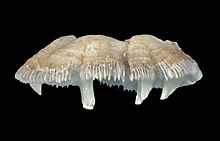
Barnacles are arthropods of the subclass Cirripedia in the subphylum Crustacea. They are related to crabs and lobsters, with similar nauplius larvae. Barnacles are exclusively marine invertebrates; many species live in shallow and tidal waters. Some 2,100 species have been described.

Thoracica is an infraclass of crustaceans which contains the most familiar species of barnacles found on rocky coasts, such as Semibalanus balanoides and Chthamalus stellatus. They have six well-developed limbs, and may be either stalked or sessile. The carapace is heavily calcified. The group includes free-living and commensal species.

Thecostraca is a class of marine invertebrates containing over 2,200 described species. Many species have planktonic larvae which become sessile or parasitic as adults.

The Balanidae comprise a family of barnacles of the order Balanomorpha. As a result of research published in 2021 by Chan et al., the members of the family Archaeobalanidae were merged with this family.

Sessilia is an unranked clade of barnacles, comprising the barnacles without stalks, or acorn barnacles. They form a monophyletic group and are probably derived from stalked or goose barnacles. Sessilia is divided into two orders. The Verrucomorpha contain two families, Verrucidae and Neoverrucidae, and the remaining 14 families are in the order Balanomorpha.

The Balanomorpha are an order of barnacles, containing familiar acorn barnacles of the seashore. The order contains these families:

Whale barnacles are species of acorn barnacle that belong to the family Coronulidae. They typically attach to baleen whales, and sometimes settle on toothed whales. The whale barnacles diverged from the turtle barnacles about three million years ago.
In the past, Anelasmatidae has been considered a family of barnacles of the order Lepadiformes. Research published in 2021 by Chan et al. resulted in the sole genus of this family, Anelasma, being moved to the family Pollicipedidae, and this family is no longer used.
Oxynaspis is a genus of goose barnacles in the order Lepadiformes.
In the past, Apygophora has been considered an order of barnacles. Research published in 2021 by Chan et al. resulted in the orders Apygophora and Pygophora being classified as families under the order Lithoglyptida.

Scalpellomorpha is an order of acorn barnacles in the class Thecostraca. There are about 11 families in 3 superfamilies and more than 450 described species in Scalpellomorpha.
In the past, Pygophora has been considered an order of barnacles. Research published in 2021 by Chan et al. resulted in the orders Pygophora and Apygophora being classified as families under the order Lithoglyptida.
Cryptophialidae is a family of Acrothoracican barnacles in the order Cryptophialida, the sole family of the order. There are at least 2 genera and more than 20 described species in Cryptophialidae. These barnacles burrow into calcareous rocks and structures, such as limestone, shells, or corals.

Pachylasmatidae is a family of symmetrical sessile barnacles in the order Balanomorpha. There are about 10 genera and at least 30 described species in Pachylasmatidae.
Archaeolepadomorpha is an extinct order of barnacles in the class Thecostraca. There are at least 3 families and more than 40 described species in Archaeolepadomorpha.

Brachylepadidae is an extinct family of barnacles in the order Brachylepadomorpha, the sole family in the order. There are about 7 genera and more than 20 described species in Brachylepadidae.
Iblomorpha is a small order of barnacles in the class Thecostraca. There are only two families and about eight described species in Iblomorpha. In this group we find barnacles that use calcium phosphate in their shell, and species that protect themselves against predators with poison.
Eolepadomorpha is an extinct order of barnacles in the class Thecostraca. There are 2 families and about 14 described species in Eolepadomorpha.

Calanticomorpha is an order of acorn barnacles in the class Thecostraca. There are 3 families and more than 90 described species in Calanticomorpha.

Pollicipedomorpha is an order of pedunculated barnacles in the class Thecostraca. There are 3 families and more than 30 described species in Pollicipedomorpha.










